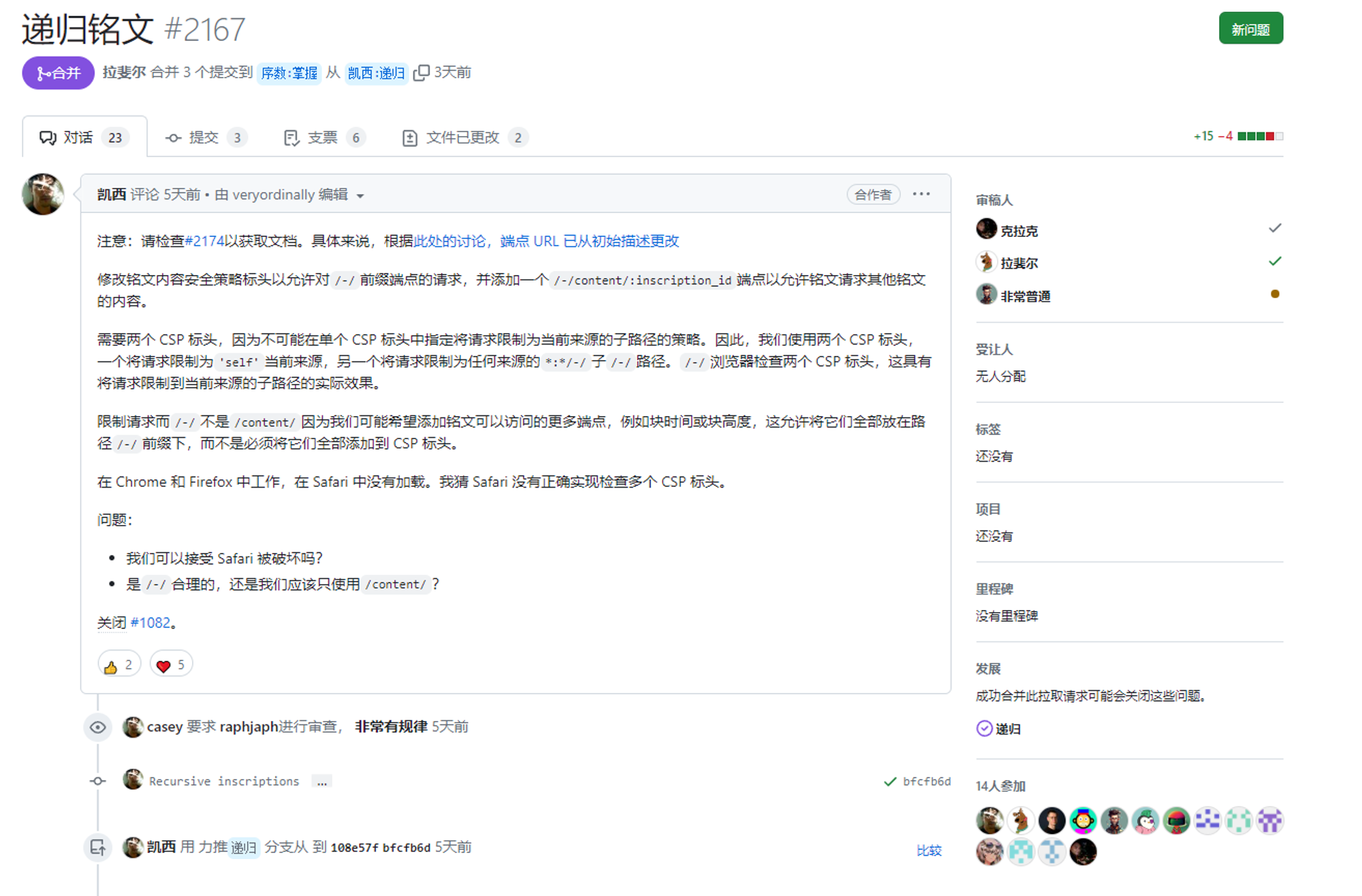Will Recursive Markings Trigger the Next Wave of BTC Ecology?
Recursive markings and BTC ecology: Next wave?Author: Yinan
Recently, Raph, the new chief maintainer of the Bitcoin protocol Ordinals, merged the “recursive inscriptions” #2167 update proposed by Casey Rodarmor, the creator of the Bitcoin protocol Ordinals, into the Ordinals code on GitHub.
Recursive inscriptions refer to a way of engraving on the blockchain that has the characteristic of self-reference. In the previous way of engraving, each inscription was independent and there was no connection between them. However, by introducing recursive inscriptions, this situation is about to change.
Recursive inscriptions allow the use of the special “/-/content/:inscription ID” syntax to request the content of other inscriptions. This simple change opens up endless possibilities.
- a16z will open an office in London and plans to launch a blockchain accelerator project.
- Preview of a New Project | Rodeo, a Leveraged DeFi Mining Project: Could it Become the Leveraged Center of the Arbitrum Ecosystem?
- Quick Look at Token Unlocking Status of Mainstream Projects in June
For example, instead of engraving 10,000 JPEG files separately for a PFP collection (which would be very expensive), it is better to engrave 200 features from the collection and then request these 200 features through the new inscription syntax, combine them to make 10,000 inscriptions, use a small amount of code to request features and present images through programming. This will greatly reduce transaction costs while breaking through the limitations of inscription image size.

Simply put, for those familiar with NFTs, most of the 10,000 NFT collections are composed of a dozen or dozens of parts. Taking character PFP as an example, they generally include background, hat, hair accessory, eyes, accessories, clothing, pants, shoes and other parts, and then these parts are arranged and combined to form 10,000 images.

Recursive inscriptions just need to upload these dozens of components, and then call these components through syntax, and then perform a combination. The previous method was to combine first and then upload, but recursive inscriptions have changed this way. This will save costs to a large extent and provide more possibilities.
These uploaded components will form a material library, and everyone will be able to call them. Artists and creators will be able to do a good job of post-production on this and open up their imaginations.
Possibilities:
NFT/Inscription Collection with Combinability: After the previous release of Moonbird, there came AIMoonbird, a secondary creation of blue chip projects. The emergence of recursive inscriptions will greatly enhance the combinability of artistic creation, such as art, digital assets, on-chain games, etc.
Decentralized Websites: Recently, Casey answered a question from a community member, and the inscription type added “JS” and “CSS” types, which means that there may be dynamic websites that exist on decentralized networks and never disappear in the future.
Fragmentation of NFTs: Since they are combinable, can they be disassembled and fragmented for further operations?
Domain Name System: With the enhancement of the combinability of inscriptions, can domain names not only link an address, but also carry more things, such as linking to web pages or pointing to included NFTs, etc.
Summary:
Currently, recursive inscriptions have only been proposed for 3 days, which can be considered a social experiment, but it has attracted the attention and discussion of a large part of the crypto community. Whether it can cause the next wave of enthusiasm in the BTC ecology needs time to verify, but often where there is a hot spot, there is an opportunity.
When new things appear, we need to keep a keen sense of smell, maintain curiosity and exploration ability for new things, and conduct appropriate research and participation, which will have different gains.
Related Links:
Github: https://github.com/ordinals/ord/pull/2167#issuecomment-1586342841
Ordinals browser: https://ordinals.com/
We will continue to update Blocking; if you have any questions or suggestions, please contact us!
Was this article helpful?
93 out of 132 found this helpful
Related articles
- Inventory of Catalysts Coming to the Cryptocurrency Industry: GMX V2, Camelot Upgrade, Lybra Finance V2…
- Introducing Ark: a privacy-focused alternative Bitcoin scaling solution
- a16z: A detailed explanation of the working principle of Cicada, a ZK-based on-chain voting project
- Ethereum Ecosystem Weekly Report: Cancun EIP list confirmed, EIP-4844 Devnet 6 to launch next week, Optimism completes mainnet Bedrock upgrade…
- Quick Overview of Five GameFi Projects Worth Paying Attention to in ETHGlobal Hackathon
- Long push: 9 promising projects that have received VC investment recommendations
- Inventory of Potential Early LSDFi Projects






